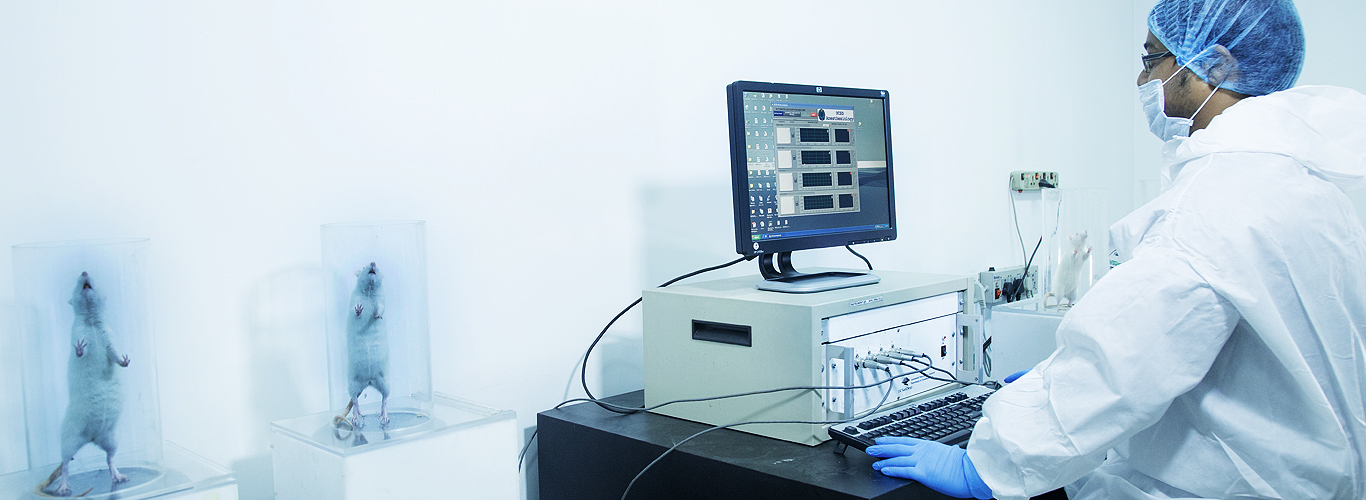Contact E-mails
-
BD Inquiries
-
Japan
-
HR Inquiries
In Vivo Pharmacology
 Preclinical Discovery
Preclinical Discovery
TCG Lifesciences’ in vivo services provide validated platforms for regular screening as well as in-depth studies in multiple therapeutic areas like pain, inflammation, oncology, CNS, gastroenterology etc. with a proven track record of supporting successful collaborations globally for more than 16 years. The development of platforms for oncology and anti-bacterial screens are in progress. The in vivo team comprised of experts in pharmacology and veterinary sciences provide complete support from study design to final data analysis and reporting. The team also offers the flexibility of using available platforms for developing customized models efficiently to support the preclinical discovery program. The team of in vivo scientists works in concert with in vitro and bioanalytical teams to support more complex studies like PK/PD correlation along with biomarker analysis to maximize the value of obtained research data.
The state-of-the-art rodent facility of TCGLS is registered with CCSEA, Govt. of India and governed by Institutional Animal Ethics Committee (IAEC). The entire facility is equipped with Individually Ventilated Cage (IVC) system for holding and breeding of rats and mice. Blanket import license is also in place for procurement of specific strains from international sources as per project requirement. The existing facility is recently expanded further with additional 10,000 sq ft of AAALAC facility for capacity enhancement in the area of in vivo studies

Efficacy Model Portfolio Across Therapeutic Areas
Pain Models
Neuropathic Pain
- Spinal Nerve Ligation
- Spared Nerve Injury
- Chronic Constriction Injury
- Partial Sciatic Nerve Ligation
- Diabetic Neuropathy
- Chemotherapy induced Neuropathic Pain
Inflammatory Pain
- UV Burn Induced Hyperalgesia
- CFA Induced Hyperalgesia
- MMT/MIA Induced OA Pain
- Capsaicin Induced Pain
- Post Operative Pain
- Formalin induced Pain
Visceral Pain
- Acetic Acid Induced Writhing
Mechanical & Thermal Nociception
- Rat Pinch Model
- Hot Plate
Inflammation Models
- Carrageenan Induced Paw Edema
- Carrageenan Induced Air Pouch Inflammation
- LPS Induced Endotoxemia
- LPS Induced Lung Inflammation
- Collagen Induced Arthritis
- BDL/CCL4 Induced Liver Fibrosis
- BDL Induced Liver Cirrhosis
- Nonalcoholic Steatohepatitis (NASH)
Oncology Models
Xenograft Models
- Breast (MDA-MB-231)
- Skin (A431)
- Lung (A549)
- Colon (HCT-116)
- Prostate (PC-3)
Syngeneic Models
- Colon (CT26.WT)
- Beast (EMT-6)
Portfolio Expansion In Progress
Gastrointestinal Models
- DSS Induced Colitis
- Gastric Ulcer
- Colonic Motility
Diabetes Models
- Oral Glucose Tolerance Test
- STZ Induced T1DM
Dermatology Models
- Compound 48/80 Induced Itch
- β-Alanine Induced Itch
- Oxazolone Induced DTH Model
- IMQ Induced Psoriasis: Under Development
CNS Models
Cognition
- Contextual Fear Conditioning (CFC)
- Novel Object Recognition Test (NORT)
Anxiety & Depression
- Forced Swim Test (FST)
- Marble Burying Test (MBT)
- Novelty Suppressed Feeding (NSF)
- Tail Suspension Test (TST)
Neurodegeneration
- MPTP Induced Parkinson’s Disease- Under Development
Brain Slice Electrophysiology
- LTP, LTD Recordings In Hippocampal Slices
Early Toxicity Studies
- Median Lethal Dose (LD50) Finding
- Maximum Tolerated Dose (MTD) Finding
- Dose Range Finding (DRF)
- Tolerability Studies
Toxicokinetic (TK) Studies
- TK Parameters: Plasma/Blood Conc., Cmax, Tmax, t1/2, AUC, CL etc. usingWinNonLin, if applicable
- LC-MS-MS based analysis for small molecule analyte
Adverse Event Profiling
- Locomotor Activity (Linton’s Activity Monitor)
- Rotarod test
List of state of the art equipment>>



